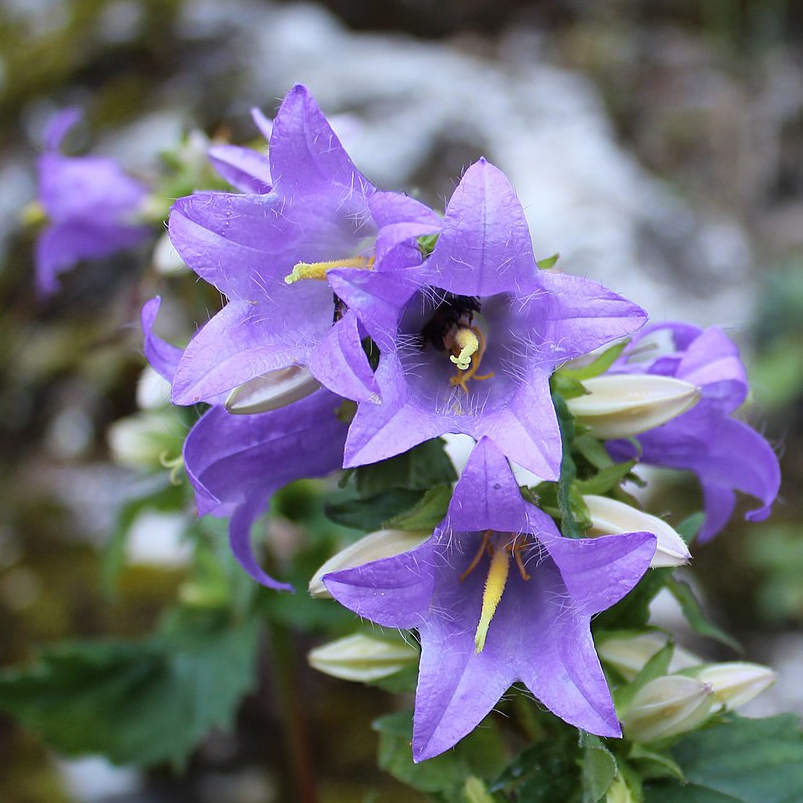Giant Bellflower Campanula latifolia
Herbaceous perennial – up to 1.5m tall c30cm spread
Flowering – July to August
Soils - Neutral to alkaline
Position – Full sun or partial shade
- Home
- Wild Plants
- Wildflowers
- Shade plants
- Giant bellflower
This is a striking tall perennial with upward-facing mid blue flowers, found typically in rich calcareous soils in woods and hedgerows. White-flowered plants also sometimes occur. It is distributed throughout Britain but is uncommon in the south of England, Wales, and the north of Scotland1. . It was first recorded botanically in Britain by Johnson in 16332. .
Grigson reported that its leaves and stem tip could be cooked and eaten like spinach3. .
It has long been grown in gardens and horticultural forms are available with darker-coloured flowers. Some of these may be of hybrid origin. We suggest obtaining this plant from suppliers of native wild flowers to ensure authentic provenance.
It is happy in a fertile soil in any garden border, preferring semi-shade where it can make quite an impact.
It is pollinated by bumblebees, and also attracts the solitary bees Melitta haemorrhoidalis (the gold-tailed melitta) and Chelostema campanularum (the small scissor bee) both of which are obligate feeders on Campanula pollen4. . These are currently recorded from southern England, but are likely to extend their area of distribution northwards with climate change.
The foliage of Campanula species has been recorded as a food plant of the caterpillars of two moths, the lime-speck pug Eupithecia centaureata and the campanula pug Eupithecia denotata5. . It is eaten by stem-boring larvae of the rather spectacular banded bellflower fly Platyparea discoidea, but few other insects6. .
References
1. Stace, C. (2010) New Flora of the British Isles, Third Edition. P. 674.
2. Pearman, D. (2017). The Discovery of the Native Flora of Britain and Ireland, Botanical Society of Britain & Ireland. P.126
3. Grigson, G. (1995). An Englishman’s Flora. P338.
4. Falk, S. (2015) Field Guide to the Bees or Britain and Ireland. P. 261. And P. 271.
5. Crafer, T. (2005). Foodplant List of Britain’s Butterflies and Larger Moths.
6. See the Biological Record Centre database
Page written by Marc Carlton. Compiled by Steve Head
Giant Bellflower Campanula latifolia
Family – Campanulaceae, Bellflower family
Herbaceous perennial – up to 1.5m tall c30cm spread
Flowering – July to August
Soils - Neutral to alkaline
Position – Full sun or partial shade




This is a striking tall perennial with upward-facing mid blue flowers, found typically in rich calcareous soils in woods and hedgerows. White-flowered plants also sometimes occur. It is distributed throughout Britain but is uncommon in the south of England, Wales, and the north of Scotland1. . It was first recorded botanically in Britain by Johnson in 16332. .
Grigson reported that its leaves and stem tip could be cooked and eaten like spinach3. .
It has long been grown in gardens and horticultural forms are available with darker-coloured flowers. Some of these may be of hybrid origin. We suggest obtaining this plant from suppliers of native wild flowers to ensure authentic provenance.
It is happy in a fertile soil in any garden border, preferring semi-shade where it can make quite an impact.
It is pollinated by bumblebees, and also attracts the solitary bees Melitta haemorrhoidalis (the gold-tailed melitta) and Chelostema campanularum (the small scissor bee) both of which are obligate feeders on Campanula pollen4. . These are currently recorded from southern England, but are likely to extend their area of distribution northwards with climate change.
The foliage of Campanula species has been recorded as a food plant of the caterpillars of two moths, the lime-speck pug Eupithecia centaureata and the campanula pug Eupithecia denotata5. . It is eaten by stem-boring larvae of the rather spectacular banded bellflower fly Platyparea discoidea, but few other insects6. .
References
1. Stace, C. (2010) New Flora of the British Isles, Third Edition. P. 674.
2. Pearman, D. (2017). The Discovery of the Native Flora of Britain and Ireland, Botanical Society of Britain & Ireland. P.126
3. Grigson, G. (1995). An Englishman’s Flora. P338.
4. Falk, S. (2015) Field Guide to the Bees or Britain and Ireland. P. 261. And P. 271.
5. Crafer, T. (2005). Foodplant List of Britain’s Butterflies and Larger Moths.
Page written by Marc Carlton. Compiled by Steve Head







